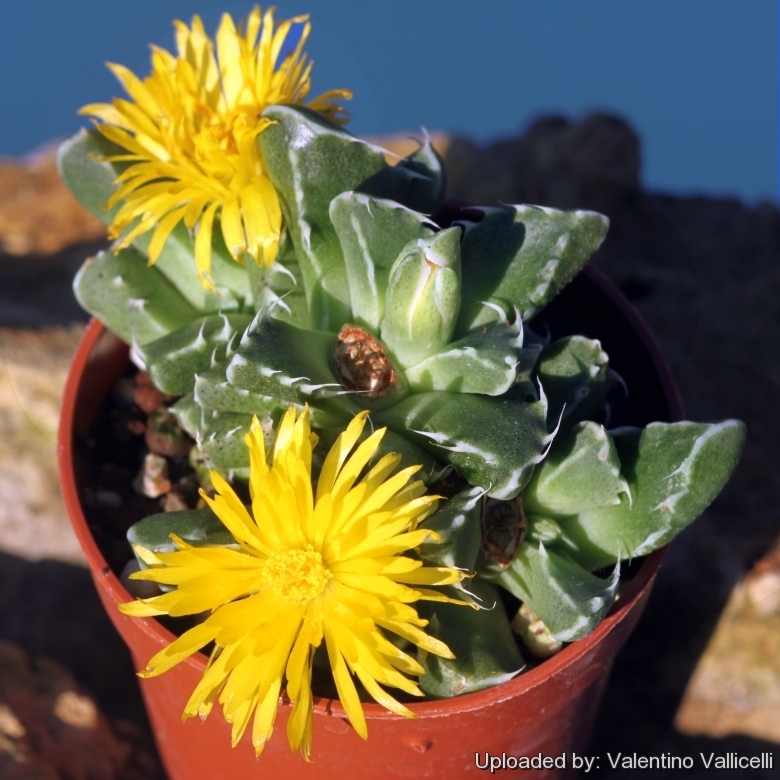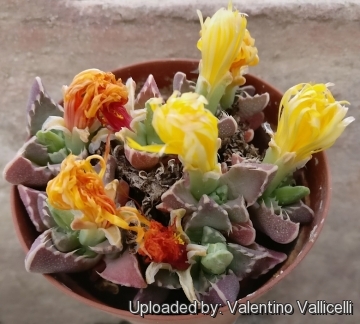Accepted Scientific Name: Faucaria bosscheana (A.Berger) Schwantes
Z. Sukkulentenk. 2: 177 1926.

Faucaria albidens Photo by: Valentino Vallicelli
Origin and Habitat: South Africa (Cape province)
Synonyms:
See all synonyms of Faucaria bosscheana
back
Accepted name in llifle Database:Faucaria bosscheana (A.Berger) SchwantesZ. Sukkulentenk. 2: 177 1926.Synonymy: 8
back
Common Names include:
ENGLISH: Tiger-Jaws
Description: Faucaria albidensSN|17876]]SN|17880]] is a local or morphological form of the widespread and variable Faucaria bosscheanaSN|17880]]SN|17876]]. Faucaria albidensSN|17880]]SN|17880]] differs mainly for its beautiful white teeth and leaf margins which appear as if coated with white enamel and this accounts for the name albidens, which means white toothed. However the distinguishing characteristics of Faucaria albidensSN|17876]]SN|17880]], appear to fall within the natural variation of Faucaria bosscheanaSN|17880]]SN|17876]] and it should be synonymized with the latter, but it still has a value for a collector because they identify plants with particular characters.
Leaves: The species has compact rosettes with 5 or 6 pairs of leaves 2,5 cm long, wider in the middle, elongated, triangular and tapering; they are fresh green with small dots, and the white margins have 3 to 5 recurved teeth.
Leaves: Small, glossy green leaves, dotted on surface, and a few whitish teeth.
Flower: Golden-yellow. Easily grown it blooms in late summer.
Bibliography: Major references and further lectures
1) John Robert Brown “Unusual Plants: 110 Spectacular Photographs of Succulents” Abbey Garden Press, 1954
2) S. H. Scott “The Observer's Book of Cacti and Other Succulents” F. Warne, 1958
 Faucaria albidens Photo by: Valentino Vallicelli
Faucaria albidens Photo by: Valentino VallicelliSend a photo of this plant.The gallery now contains thousands of pictures, however it is possible to do even more. We are, of course, seeking photos of species not yet shown in the gallery but not only that, we are also looking for better pictures than those already present.
Read More... Cultivation and Propagation: Faucarias are la good choice for anyone wanting to start growing succulents. They are quite hardy and can take a short period of light frost and in very dry warm regions these succulents make very impressive out door ground covers. They need full sun to light shade with a well-drained soil mix, but can tolerate a wide variety of soil types and growing locations as long as there is plenty of sun. The plants are well watered during the growing season and allowed to dry thoroughly before watering again and will tolerate some over watering, but the challenge is to help them keep their compact form and prevent elongation of the stem. During the winter months, the plants should be kept very dry, only watering enough to keep the leaves from shrivelling.
As house plants they tend to grow in fair weather and rest when temperatures are too hot or too cool.
Propagation: Faucaria is very easy to start from seed. Seeds germinate in 7-14 days at 21°C. Although they will start from cuttings, it is quite difficult to get them to root. If they start to rot there is usually part of the plant that can be removed and possibly rooted.












